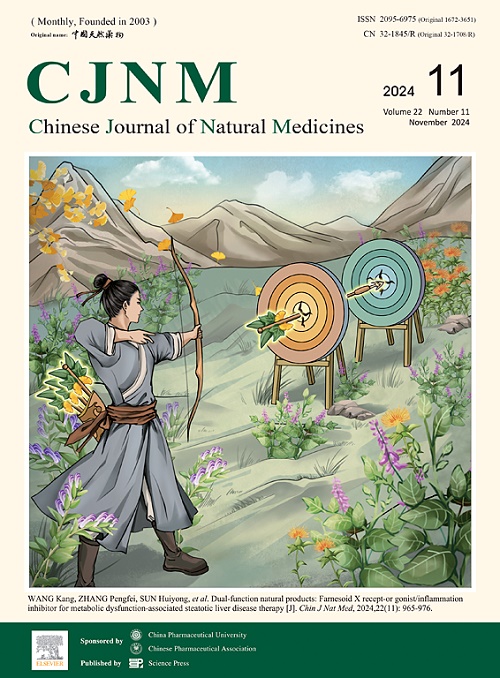Zishen Huoxue decoction (ZSHX) alleviates ischemic myocardial injury (MI) via Sirt5-β-tubulin mediated synergistic mechanism of “mitophagy-unfolded protein response” and mitophagy
IF 4.9
2区 医学
Q1 INTEGRATIVE & COMPLEMENTARY MEDICINE
引用次数: 0
Abstract
Zishen Huoxue decoction (ZSHX) enhances cardiomyocyte viability following hypoxic stress; however, its upstream therapeutic targets remain unclear. Network pharmacology and RNA sequencing analyses revealed that ZSHX target genes were closely associated with mitophagy and apoptosis in the mitochondrial pathway. In vitro, ZSHX inhibited pathological mitochondrial fission following hypoxic stress, regulated FUN14 domain-containing protein 1 (FUNDC1)-related mitophagy, and increased the levels of mitophagy lysosomes and microtubule-associated protein 1 light chain 3 beta II (LC3II)/translocase of outer mitochondrial membrane 20 (TOM20) expression while inhibiting the over-activated mitochondrial unfolded protein response. Additionally, ZSHX regulated the stability of beta-tubulin through Sirtuin 5 (SIRT5) and could modulate FUNDC1-related synergistic mechanisms of mitophagy and unfolded protein response in the mitochondria (UPRmt) via the SIRT5 and -β-tubulin axis. This targeting pathway may be crucial for cardiomyocytes to resist hypoxia. Collectively, these findings suggest that ZSHX can protect against cardiomyocyte injury via the SIRT5-β-tubulin axis, which may be associated with the synergistic protective mechanism of SIRT5-β-tubulin axis-related mitophagy and UPRmt on cardiomyocytes.
紫参活血汤通过Sirt5-β-微管蛋白介导的“线粒体自噬-未折叠蛋白反应”和线粒体自噬的协同机制减轻缺血性心肌损伤
紫参活血汤提高缺氧应激后心肌细胞活力;然而,其上游治疗靶点仍不清楚。网络药理学和RNA测序分析显示,ZSHX靶基因在线粒体途径中与线粒体自噬和凋亡密切相关。在体外,ZSHX抑制缺氧应激后的病理性线粒体裂变,调节FUN14结构域蛋白1 (FUNDC1)相关的线粒体自噬,提高线粒体自噬溶酶体和微管相关蛋白1轻链3 β II (LC3II)/线粒体外膜20转座酶(TOM20)的表达水平,同时抑制线粒体未折叠蛋白的过度激活反应。此外,ZSHX通过SIRT5 (SIRT5)调节β-微管蛋白的稳定性,并可通过SIRT5和-β-微管蛋白轴调节与fundc1相关的线粒体自噬和未折叠蛋白反应(UPRmt)的协同机制。这种靶向途径可能对心肌细胞抵抗缺氧至关重要。综上所述,这些发现表明ZSHX可以通过SIRT5-β-微管蛋白轴保护心肌细胞免受损伤,这可能与SIRT5-β-微管蛋白轴相关的线粒体自噬和UPRmt对心肌细胞的协同保护机制有关。
本文章由计算机程序翻译,如有差异,请以英文原文为准。
求助全文
约1分钟内获得全文
求助全文
来源期刊

Chinese Journal of Natural Medicines
INTEGRATIVE & COMPLEMENTARY MEDICINE-PHARMACOLOGY & PHARMACY
CiteScore
7.50
自引率
4.30%
发文量
2235
期刊介绍:
The Chinese Journal of Natural Medicines (CJNM), founded and sponsored in May 2003 by China Pharmaceutical University and the Chinese Pharmaceutical Association, is devoted to communication among pharmaceutical and medical scientists interested in the advancement of Traditional Chinese Medicines (TCM). CJNM publishes articles relating to a broad spectrum of bioactive natural products, leading compounds and medicines derived from Traditional Chinese Medicines (TCM).
Topics covered by the journal are: Resources of Traditional Chinese Medicines; Interaction and complexity of prescription; Natural Products Chemistry (including structure modification, semi-and total synthesis, bio-transformation); Pharmacology of natural products and prescription (including pharmacokinetics and toxicology); Pharmaceutics and Analytical Methods of natural products.
 求助内容:
求助内容: 应助结果提醒方式:
应助结果提醒方式:


